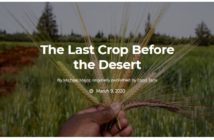 DAKAR, 25 October 2012 (IRIN) – Swarms of desert locusts are likely to migrate to Algeria, Libya, Mauritania and Morocco in the coming weeks from West Africa and the Sahel region, says the UN Food and Agriculture Organization (FAO) [ link/ ], which urges the four countries to prepare for pest control.
DAKAR, 25 October 2012 (IRIN) – Swarms of desert locusts are likely to migrate to Algeria, Libya, Mauritania and Morocco in the coming weeks from West Africa and the Sahel region, says the UN Food and Agriculture Organization (FAO) [ link/ ], which urges the four countries to prepare for pest control.
Clouds of adult locusts are developing in Chad and are about to form in Mali and Niger after plentiful rains during the June-September rainy season favoured the breeding of two generations [ link ] of locusts and increased their population 250 times.
When they migrate to northwestern African countries, they are “expected to arrive in areas where there has been recent rainfall and with green vegetation… there could be impacts on associated livelihoods,” Keith Cressman, FAO’s senior locust forecasting officer, told IRIN.
Prevailing winds and past trends make it likely that the swarms, once formed, will fly to Algeria, Libya, southern Morocco and northwestern Mauritania, he said in a statement on 23 October.
The insects initially migrated to northern Mali and Niger in June from Algeria and Libya. Insecurity in northern Mali, a region overran by Islamist rebels, has made assessments difficult. In Chad, ground teams began spraying the insects in October, and Niger, where pest control teams have to be accompanied by the military, has recently begun spraying.
“The control operations are reducing locust numbers and infestations in both Niger and Chad. This will in turn reduce the scale of migration, but migration is still expected to occur since it is difficult to find and control all locust infestations in the large expanses of northern Niger and Chad,” Cressman said.
Swarms of tens of millions of locusts can fly up to 150km a day with the wind. Female locusts can lay 300 eggs in their lifetime and an adult desert locust can eat food about its own weight every day (around two grams). A very small swarm eats the same amount of food in one day as about 35,000 people, says FAO.
In 2004 swarms of locusts up to 20km long and 5km wide devastated pastures, crops and vegetation across the Sahel from Dakar, the capital of Senegal on the Atlantic coast, to N’djamena, the capital of Chad, half a continent away.
ob/cb
.






